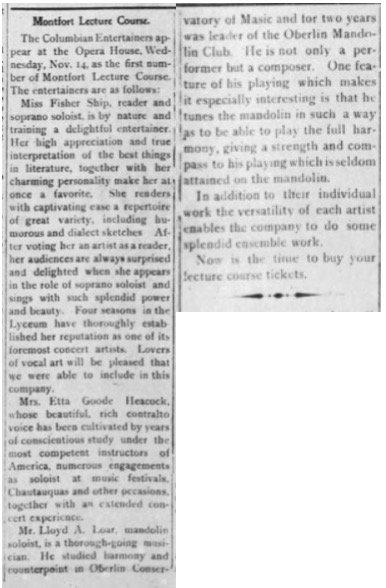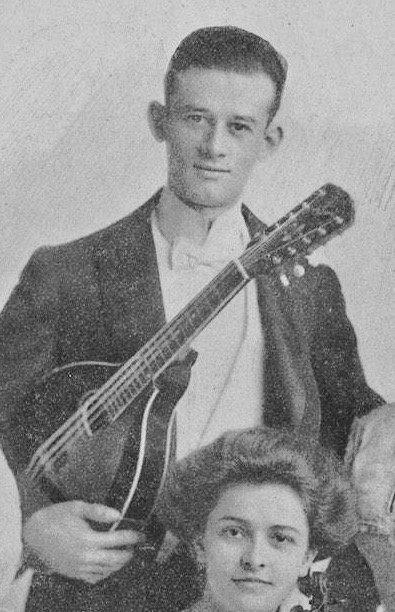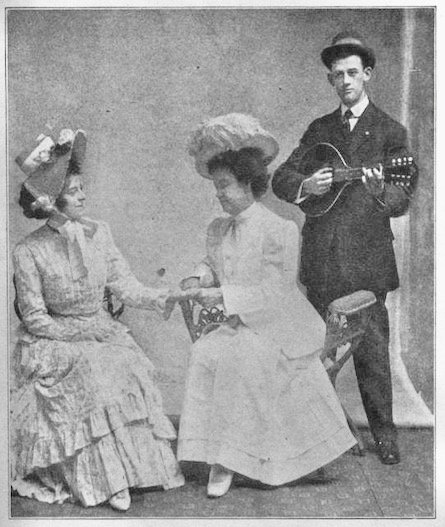In 1903, seventeen-year old mandolin enthusiast Lloyd Allayre Loar graduated high school in his home town of Lewiston, Illinois. After a summer working in his father’s drug store, he headed to Ohio to attend Oberlin College. That same year, the catalog of the Gibson Mandolin Company of Kalamazoo, Michigan proclaimed that they had created the “First Serious Mandolins.” At an astronomical $221.63, model F-4 was an ornate, uniquely constructed mandolin richly inlaid with “Sidney Pearl” and featured engraved hardware plated in “Roman Gold.”
Inside front cover of the 1903 Gibson Catalog “A”
Nineteen years later, March 1922, at the Gibson Mandolin Guitar Factory on 225 Parsons Street in Kalamazoo, Michigan, Acoustic Engineer Loar is immersed in a plan to make those serious mandolins much better. Since an integral aspect of his master plan is to schedule high-profile performances with those instruments, he would have good news for General Manager Lewis A. Williams: The Gibsonians, with their dual purpose to perform in concert and promote the new Gibson instruments, were booked on the Chautauqua circuit with William Jennings Bryan. Often called “America’s Greatest Speaker” and “The Great Commoner,” Bryan drew huge audiences. It is difficult to imagine that the musicians Loar had in mind for this tour shared Bryan’s political views, especially with Bryan’s distrust of science and support of Prohibition. His famous “Cross Of Gold” speech had convinced Congress to drop the Gold Standard for US currency and embrace silver coinage, thus earning him the title “The Silver-tongued Orator.”
The Muscatine Journal (Muscatine, Iowa) · Friday, Mar 31, 1922
Along with this news, did Williams joke to Loar that there should be no Roman gold on the new style 5? The new arrow-pointed tuners would have to be silver plated!
How did this teen-aged mandolin player emerge as Master Loar of The Gibson Mandolin Company? The pivotal point for him came in late 1905 when this promising student of the physics of music and prodigy on mandolin, violin, viola, mandola, banjo and piano, dropped out of Oberlin College to hitch his rising star to the voice and stage presence of Miss Sallie Fisher Shipp from the tiny town of Brookfield in Linn County, Missouri.
Lloyd Loar and Sallie Fisher Shipp: They were stars of the Chautauqua circuit for 10 years before they were married.
Born in April of 1878 to grocer (and later traveling salesman) Anderson Doniphan Shipp and Margaret Eastin, Fisher Shipp attended the Academy of Music in Boston where she excelled as reader, singer and actress. Graduating in 1900, she was already performing professionally by the summer of 1901 and her star continued to rise and blossom for the next 5 years.
Loar was on tour with her full time by 1906 as “The Columbian Entertainers Featuring Fisher Shipp”—booked by the Chicago Lyceum Bureau.
Montfort Mail, Montfort Wisconsin, October 18 1906, points out Loar’s unique tuning of the Mandola.
By 1908, They became “The Fisher Shipp Concert Company,” and by 1910, Lloyd Loar assumed the role of booking and management as well as musical director. The 1910 Official Census of the United States lists Lloyd Loar’s occupation as “musician, manager of the ‘Fisher Shipp Concert Company.”’ Their lively show blended music with dramatic readings and short comedic theatrical sketches.
From the Chautauqua program of the 1915-1916 season, L to R: Lloyd Loar, Fisher Shipp, Miss Francis “Mamie” Allen, (contralto and piano) and Miss Freda Bethig (violin_.
Fisher Shipp’s quick costume changes amazed audiences, and their skit, “Orange Blossom” was often reviewed with great delight. In this skit, Lloyd Loar plays Professor Paddyroosky!
Lloyd Loar built his first mandolin while a student at Oberlin. It is not known to be extant. In the 1905-1906 Oberlin yearbook Loar is shown with a Martin mandolin and listed as the leader of the Oberlin Mandolin Ensemble. However, by the time the book went to press, he was already on tour with “The Columbian Entertainers featuring Fisher Shipp.” Some of the earliest accolades for his performance refer to a custom built instrument, a 10-string mandolin-viola. Here is his recollection on how this came about and also the special tuning that he employed, on which he was able to perform dazzling solos as well as full accompaniment.
Judging by the thousands of miles they travelled and the hundreds of enthusiastic reviews they received, the show was a terrific success. Successful enough, it seems, to afford the purchase of a Gibson style F artist mandolin, possibly as early as 1906. His dream to own an instrument similar to the one he saw in the Gibson catalog just three short years earlier was realized.
In the 1910 Chautauqua brochure, he sports what appears to be a factory-built, custom 10-string Gibson mandolin-viola, which would give him the full range of his tuning and performance. It appears that a wider neck with a longer peg head with a 5-on-a-plate set of tuners was fitted onto an H-2 Gibson mandola body.
While his virtuosity was lauded in hundreds of articles during this period of his career, a writer for the Crescendo magazine reviews a particular show where Loar pulls off a feat worthy of the great Bernardo de Pace!
Next week: The road to Kalamazoo!











